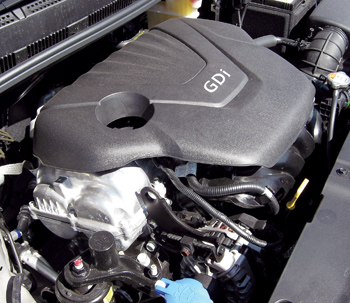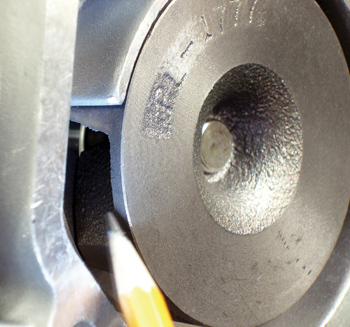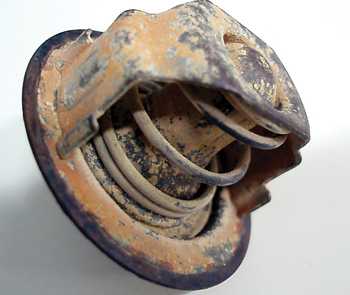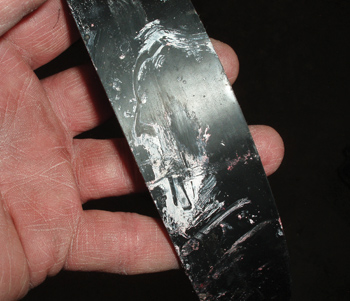
While changes in modern cooling system technology might not be apparent in day-to-day servicing, the fact is that auto manufacturers are continuing to increase fuel economy and power output by changing how the cooling system operates.
But technical change has developed very gradually. In the beginning, a few turn-of-the-century auto manufacturers relied on a thermal-expansion cooling system that was based upon the tendency of hot water to rise out of the engine cylinder head into the top of a vertical-core radiator, where it would condense and re-enter the bottom of the engine block. Although thermal expansion systems worked well on low-output engines, they were insufficient to cool the high-speed engines introduced in the 1920s. See Photo 1.
COOLING SYSTEM DEVELOPMENT
Engine-driven water pumps came into common usage early in the century. Thermostats operated by wax pellets or thermostatic springs came into common usage during the 1920s to warm the engine faster and maintain even operating temperatures. Further refinements included a cooling system bypass system designed to circulate coolant throughout the engine while it’s warming up. Some engines also use double-seat thermostats to close the bypass when the thermostat opens. Pressurized cooling systems were also introduced to prevent coolant boil-over on hot days.
The first cooling fans were conveniently mounted on the engine-driven water pumps and remain so today. During the 1960s, cooling fans were mounted on temperature-sensitive fan clutch devices to reduce power loss at the engine crankshaft. The 1960s and ’70s also saw horizontal-core radiators being introduced to accommodate reduced body height and increased cooling system demand. Many horizontal-core radiators also require remote coolant reservoirs to help evacuate air from the cooling system. Electric cooling fans began to appear on many imports because they could be activated only when engine temperatures reached a critical point. This feature not only eliminated the power loss associated with mechanical fans, it also increased fuel economy and reduced cold-engine exhaust emissions by reducing engine warm-up time. To further reduce emissions, thermostat opening temperatures were increased to about 195° F.

WATER PUMP DESIGN
The basic belt-driven water pump design in most applications hasn’t changed for many years. Most water pumps are centrifugal designs with cast or stamped metal impellors. But, some designs use molded plastic impellors. The water pump must produce enough volume to cool the engine at idle and also at full speed and power output. See Photo 2.
In concert with water pump design, thermostats are designed to slightly restrict coolant flow from the engine. This restriction allows the water pump to build additional pressure in the engine water jackets to further reduce surface boiling on the cylinder heads and to reduce pressure on the radiator header tank at high engine speeds.
At higher engine speeds, the water pump begins to “cavitate,” which means that the water pump speed has reached the point at which most of the coolant is no longer contacting the water pump impellor. At this point, a negative pressure develops along the surfaces of the water pump impellor that increases the tendency of the coolant to boil and the engine to overheat. In extreme cases, cavitation can erode water pump impellors and housings.
Many performance engine builders address this problem by installing special pulleys to reduce water pump speed. Modern auto manufacturers are similarly addressing the cavitation problem with electric water pumps.
In contrast to a belt-driven pump, the electric water pump avoids cavitation by running at a constant or at a selected, pre-programmed speed. By eliminating another belt-driven accessory to reduce rotating friction, engineers can also increase the engine’s power and fuel economy.
CYLINDER HEAD TEMPERATURES
Performance enthusiasts and engineers have known for years that increasing the engine’s compression ratio can increase power and fuel economy. But detonation, which is the sudden and spontaneous combustion of fuel contained inside the combustion chamber, is the downside of increasing compression ratio.
The force of detonating fuel is such that it breaks spark plug insulators, piston rings and pistons. Since the early 1970s, the elimination of ethyl lead has basically limited compression ratios to about 9:1 at sea level conditions to eliminate detonation.
Since an aluminum cylinder head reduces combustion chamber surface temperatures, compression ratios can be slightly increased without introducing detonation. Electronic engine controls further reduce detonation by adjusting spark timing and exhaust gas recirculation rates. Knock sensors built into most engine management systems are designed to reduce spark advance if detonation is detected. See Photo 3.
In contrast, the recent popular introduction of direct fuel injection systems, in which fuel is injected directly into the combustion chamber, also allows compression ratio increases ranging up to 13:1 on some applications. This increase is possible because the combustion process is precisely controlled and the fuel is injected into the cylinders in a manner that helps reduce combustion chamber temperatures.
Performance enthusiasts and engineers also discovered many years ago that reducing cylinder head temperatures reduced the tendency of an engine to detonate. Some high-end manufacturers have, therefore, introduced reverse-flow cooling systems in which the return coolant from the radiator flows into the cylinder heads rather than the water pump.
But reducing cylinder head temperatures also reduces fuel economy and increases the tendency of an engine to develop crankcase sludge. At the other temperature extreme, fuel atomizes better when it’s exposed to higher coolant temperatures. So it’s obvious that having full control of the engine coolant temperature can increase performance and fuel economy.
ELECTRONIC THERMOSTATS
While originally introduced on high-end imports, one of two types of electronic thermostats will undoubtedly be found on our future commuter vehicles. The first type is basically a conventional thermostat that is opened by electrically heating the surrounding coolant.
The second type is a new design in which the thermostat opening is directly electronically controlled. In either case, the powertrain control module (PCM) will use these types of thermostats to regulate engine temperature to match the demands of part-throttle and wide-open throttle operation.
COOLING SYSTEM ISSUES
Automotive engineers are currently faced with increasing the efficiency of the cooling system while reducing cooling system weight. Because many original equipment radiators have marginal cooling capacity, internally or externally clogged radiator core tubes will reduce cooling system performance to the point that an overheat condition will result.
Internal rust corrosion is the worst problem on the older cast-iron engines equipped with brass radiators, whereas electrolysis is, perhaps, the worst problem associated with modern bi-metal engines using aluminum radiators. Consequently, the additive packages in most coolants contain inhibitors that reduce corrosion caused by rust and electrolysis.
When the coolant’s additive package wears out, rust flakes from the engine’s cast-iron water jackets begin to clog the radiator core tubes. In some rare cases, the water pump impellor and other sheet-steel cooling system components like core plugs will also corrode due to poor metallurgy. In any case, rusty coolant indicates that the cooling system is headed for trouble.
Electrolysis occurs because a very mild electrical current develops between two dissimilar metals exposed to water-based solutions. Unfortunately, electrolysis tends to transfer from one metal to another. This results in the “solder bloom” found on the cores of the old soldered brass radiators. In more modern engines, electrolysis can cause cylinder head gasket failure by severely pitting cylinder head gasket surfaces and eroding the metallic portions of the gaskets themselves.
In the current market, most auto manufacturers supply long-life coolants designed to function with the specific metallurgy and designs of their cooling systems. Most manufacturers address deterioration in their additive packages by recommending scheduled coolant changes.
COOLING SYSTEM SERVICE TIPS
Modern scan tools are essential for diagnosing late-model cooling systems because a vehicle’s temperature gauge indicates only that the vehicle operating temperature is generally within normal ranges. Normal ranges include thermostat opening temperatures now exceeding 200° F and cooling fans that might not activate until operating temperatures exceed 230° F. At the very least, the coolant and intake air temperatures displayed on the data stream should closely match those taken with a non-contact pyrometer. See Photo 4.
Also check for DTCs indicating a pending or history code problem with thermostatic temperature control or coolant levels. Check cooling fan operation by turning on the air conditioner with the engine running. If your scan tool has bi-directional capability, cycle the cooling fans through their various speed ranges. Always check high-speed fan operation to ensure that the engine will cool in high-demand situations.
Visually check for debris accumulating between the air conditioner condenser and radiator. Also check for external leaks, drive belt condition, and cracked or hardened coolant hoses. Visually inspect the coolant level and color. Low coolant levels indicate internal or external leakage. Rusty or off-colored coolants might indicate that the coolant needs to be flushed.
Keep in mind that mixing various types of coolants will reduce their freezing and boiling points. If in doubt, always replace suspect coolant with original equipment or manufacturer-approved coolants.






